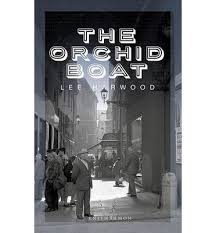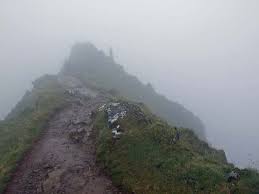I’m ashamed to confess I’ve read little of Lee Harwood’s work before, though I’m sure my old friend and poet Keith Jebb has been telling me to do so for years. Since finding this book, I’ve rushed on to the Shearsman Selected Poems with great excitement. Lee Harwood was born in 1939 and grew up in Surrey. He has spent the majority of the past 35 years living in Brighton. In a writing career that began in the early 1960s, he has published over 20 volumes of poetry and prose, as well as translations of Tristan Tzara. His work has been widely anthologised and his Collected Poems (also Shearsman) appeared in 2004.
Exterior shots in The Orchid Boat (published by Enitharmon) are full of sketchy paths, remote horizons, fogs and mists; similarly, interiors sway, hide or semi-reveal with fabrics, curtains, drapes, dresses, veils. Come to think of it, these latter images are exactly right for much of Harwood’s work as the reader seems often to be moving through lucid, well-lit spaces that are partially obscured by hangings, veils impossible to identify with any clarity, suspended above, but from what and to what end is unclear. On the other hand, I don’t want to suggest that your reading of these fantastic poems will be a disembodied or disembodying experience: Harwood is a very sensual writer and I can feel the stones on his paths beneath my feet, the heft of his furniture, the texture of a dress. If veils do fall about me they are always specific, as tactile as they should be, silken, velvet, embroidered, studded with glass and jewels. There is so much to enjoy on the journey.
One of the more subtle, ironising veils Harwood deploys is his habit of enclosing lines in inverted commas. Here’s the opening of ‘Ornithology’: “A wall of dense fog ahead / – blocked, all knowledge denied. / ‘The flying bird brings the message.’” In some writers, such a device would read as an abstracted and overly-intellectual exercise in confronting one discourse with another, but Harwood’s use of it is always far more human. There is a dialogue implied, a companionship, or at least an internal conversation occurring. The intended effect is achieved but is something as much felt as understood: a destabilising of the objective view and, of course, this is what all the fog and mist is about. World is hard to know. But Harwood’s birds, to take one example, though they may be remote and elusive, are definitely there: “As the mist shifts you see swallows set on a wire, / a wagtail bobbing on a rock”.
Uncertainties in The Orchid Boat are temporal as well as spatial. In ‘New Zealand Playback’ voices are cross-cutting again: “‘I don’t want to be here’ // stumbling around in and out of history. // No answers to that one. // ‘You should get out more.’” The latter phrase also suggests one of the things I really like about Harwood’s work: it never wanders far from the spoken, colloquial voice, however complexly layered the over-arching arrangement of phrases may be. The poems explore what can be known and what cannot and the resulting movement is to “Zig-zag around, as usual” as ‘Sailing Westwards’ expresses it. The voyage, the far horizon, appears to be one way of putting it; the mountain path with its uncertain fog-shrouded cairns, is another. Either way, the one certainty is that “We just don’t know the full story”.
The orchid boat itself is brought into view in the beautiful poem ‘Departures’. A summer night, the sound of rain, swaying curtains, a female voice, an implied intimacy between a man and a woman, but perhaps all this was “years ago”. Yet even if a memory, it is vivid as in a mirror. But such reflections are already one step away from the thing itself and there rises the lure of fixing such experiences, our human need to do so. It’s in this context that the orchid boat appears to represent the workings of our desire to protect the provisional nature of what we know and feel. “How to imagine an orchid boat? / It gets harder. But days come and go”. The boat, always boarded without “thinking” over much, carries us “beyond all mirrors”. Though age seems to increase the allure of fixity (we grow more frightened as we grow old), Harwood believes both age and childishness are states of mind rather than temporally-defined cell blocks. So ‘Childish’ presents a free-running phantasmagoria of Wordsworth-worth cleansed perceptions, concluding: “the red handrail of the pagoda / glistens with raindrops”. There goes the ghost of Carlos Williams’ red wheelbarrow too.
Indeed, Williams is a better comparison than Wordsworth. Harwood is often associated with the New York School, with Frank O’Hara and John Ashbery. Personally, I’ve always found Ashbery’s work hard to like much because (actually more like Wordsworth) there is too much of the egotistical, of the centripetal force, too much pressure from within, too little from without, too much abstraction. I prefer the way Harwood’s poems float more centifugally. They travel outwards spatially, to and fro temporally: “I’ll stamp my foot / and, checking the rear-view mirror, / head for the frontier” (‘The Books’).
There is in Harwood always the desire (and it is partly erotic) to tune in to the fullness of experience, its full presence and contradictoriness: “To stand back from the bare times – alive and alert” (‘Palaeontology’). The adjective “bare” here probably means that slimmed-down, rationalised, processed version of human experience we glide absent-mindedly though every day (a processing done in large part through the magical powers of language). In the same vein, ‘A Steady Light’ evokes the dusty orderliness of a museum with its “robes and rituals and attempts at clarity [. . . ] all copied, copied again, amended, copied again”. In the face of such suffocating restriction, to be “alive and alert” is an aspiration for Harwood, a daily hope, an occasional thrill, an anticipation of the drawing of the veil:
A curtain stirs in the tired room
while the same breeze slowly shifts
the hangings in the nearby hospital.
Distant sounds from the streets below.
Get up from the couch or chair.
Walk across the room to stop by the window.
The air heavy with the heat of summer.
Much more of Harwood’s work is available through Shearman who publish his Selected as well as a Collected 1964-2004.
Another review of The Orchid Boat, by Robert Sheppard, is available here




Dear Martin, I very much enjoyed your review of Lee Harwood’s ‘Orchid Boat’. I have a copy of his translation of Tristan Tzara and an earlier book of his. Thank you for sending the other reviews all of which help to keep me in touch with what’s happening in poetry. I’ve been in Paris for six months. A few weeks ago I had a reading of ‘Spool’ at Shakespeare and Company with an audience of ninety, it’s available on soundcloud. I just wondered, if you have time, I’d very much appreciate a review from you. Jake Oliver reviewed ‘Spool’ for New Welsh Review 103 online. Best wishes, Robt.
LikeLike
[…] the train down I was again reading Lee Harwood’s work (see my last blog post) and came across ‘Days and Night: Accidental Sightings – a bundle of 50 sticks for Joseph […]
LikeLike